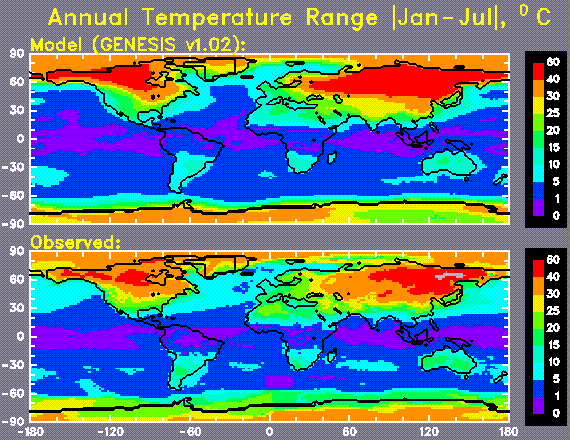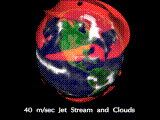
 Jet stream and fractional cloud cover
Jet stream and fractional cloud cover
The atmospheric general circulation model (AGCM) originated from the NCAR Community Climate Model version 1 (CCM1, described in Williamson et.al., 1987), although most modules have been extensively modified or replaced since work began in 1989. The exception is the spectral dynamics, whose core remains essentially unchanged. The model dynamics uses the spectral transform method in the horizontal for mass, heat and momentum. A sigma-coordinate system is used with 18 vertical levels. A diurnal cycle is included, with solar-radiation calculations performed every 1.5 hours. The solar radiation scheme of Thompson et.al. (1987) is used, which performs delta-Eddington calculations for all layers; in GENESIS we have avoided the single-effective-cloud approximation of Thompson et.al. and included multi-layer randomly overlapped clouds in the solar calculations. Also the solar effect of background tropospheric aerosols can be included. The IR radiative effects of other trace gases (CH4, N2O, CFCs) are treated explicitly instead of being lumped with CO2; this work was done by Prof. Wei-Chyung Wang's group at SUNY/Albany.
Water vapor is advected in grid space by semi-Lagrangian transport, essentially as described in Williamson and Rasch (1989), Rasch and Williamson (1990) and Williamson (1990). Convection in the atmosphere is treated using an explicit sub-grid plume model along the lines of Anthes (1977, section 4) for instance, and the same model is also used to simulate planetary boundary layer mixing. For now, the cloud parameterization is similar to Slingo and Slingo (1991), with three possible types of clouds: stratus, anvil cirrus and convective. However, work is in progress on a much improved cloud scheme with predicted cloud water amounts (Sundqvist, 1978; Tiedtke, 1994).
Gravity wave drag is included in the atmospheric dynamics, and a dynamic Courant spectral truncation in the upper stratosphere is used for numerical stability. Passive tracers can be advected using the same semi-Lagrangian scheme as for water vapor. A hybrid (sigma-pressure) vertical coordinate is used for the semi-Lagrangian transport to reduce spurious diffusion in the stratosphere. The prescribed AGCM topography has been augmented by envelope orography, which greatly improves the Indian summer monsoon.
The nominal AGCM resolutions are a spectral horizontal grid of T31 (3.75 degrees latitude and longitude) and vertical 18 levels. The AGCM horizontal grid is independent of the surface grid. Fields are transferred between the AGCM and the surface by bilinear interpolation (AGCM to surface) or straightforward area-averaging (surface to AGCM) at each timestep. The nominal surface grid resolution used by the vegetation, soil, snow, sea-ice and ocean models is 2 degrees by 2 degrees.

12/8/97